Overview of Linked Data: Technologies, Implementations, and Comparison
VerifiedAdded on 2021/04/17
|7
|1769
|170
Report
AI Summary
This report provides a comprehensive overview of linked data, exploring its core concepts, associated technologies such as URIs, HTTP, and RDF, and practical implementations. It details how linked data utilizes the web to connect resources, including diverse data sources across different organi...
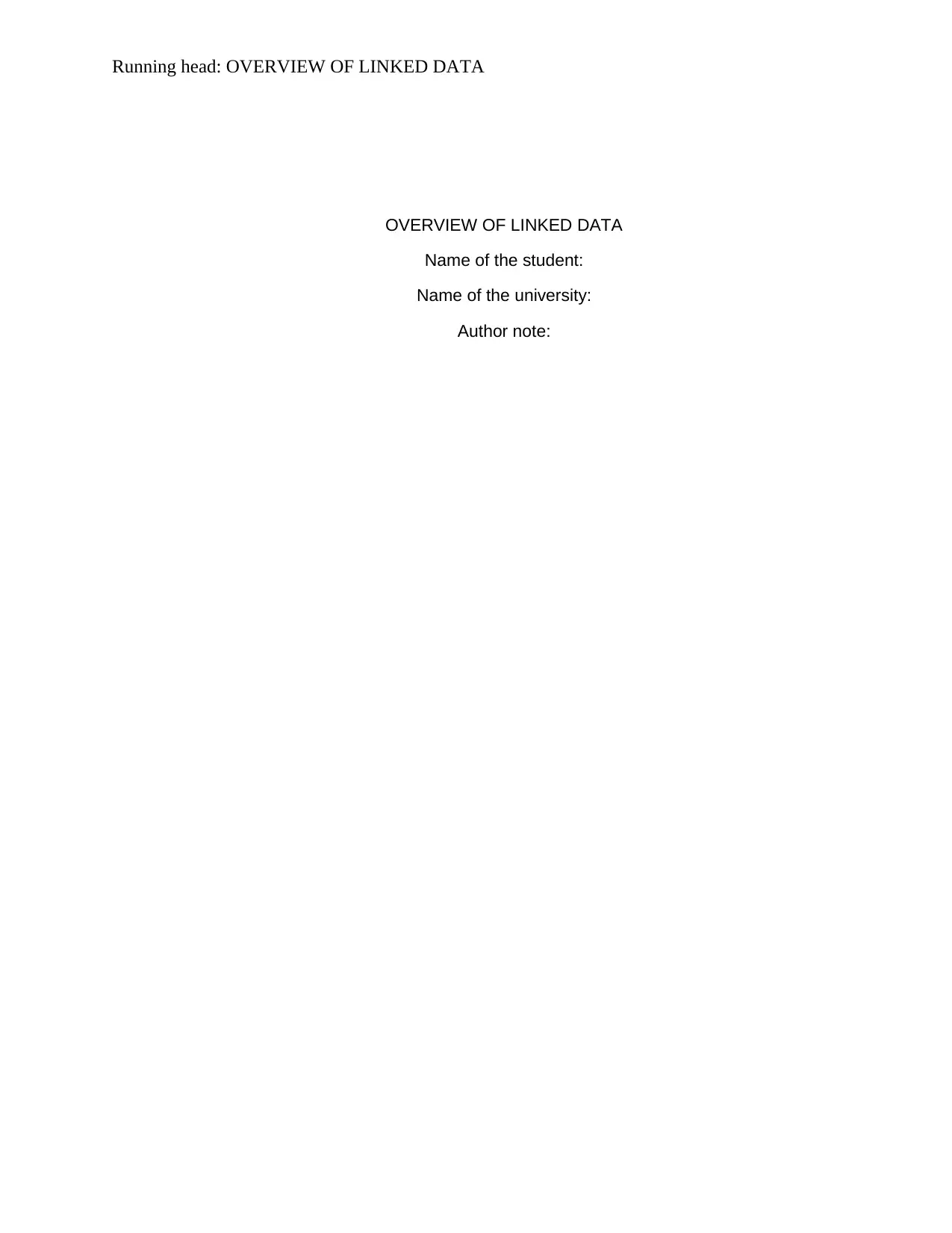
Running head: OVERVIEW OF LINKED DATA
OVERVIEW OF LINKED DATA
Name of the student:
Name of the university:
Author note:
OVERVIEW OF LINKED DATA
Name of the student:
Name of the university:
Author note:
Paraphrase This Document
Need a fresh take? Get an instant paraphrase of this document with our AI Paraphraser

1OVERVIEW OF LINKED DATA
Introduction:
The report describes the concept of linked data and various associated tools. The report
first gives a brief overview of the linked data like what is meant by linked data, for what purpose
the technology used. The following section after the brief overview is followed by the associated
tools of linked data technology. The tools and techniques and their functionalities has been
described in details in this section. The next sections talks about the practical implementations
of the technology and for this some practical projects based on the linked data concept has
been mentioned.
The report also outlines the comparison between linked data and NOSQL, a popular
database technology used for modern database design. The comparison describes the
important features of the respective technologies and how this features has helped in solving
various problems in the particular fields for which the technology is adopted.
Introduction:
The report describes the concept of linked data and various associated tools. The report
first gives a brief overview of the linked data like what is meant by linked data, for what purpose
the technology used. The following section after the brief overview is followed by the associated
tools of linked data technology. The tools and techniques and their functionalities has been
described in details in this section. The next sections talks about the practical implementations
of the technology and for this some practical projects based on the linked data concept has
been mentioned.
The report also outlines the comparison between linked data and NOSQL, a popular
database technology used for modern database design. The comparison describes the
important features of the respective technologies and how this features has helped in solving
various problems in the particular fields for which the technology is adopted.
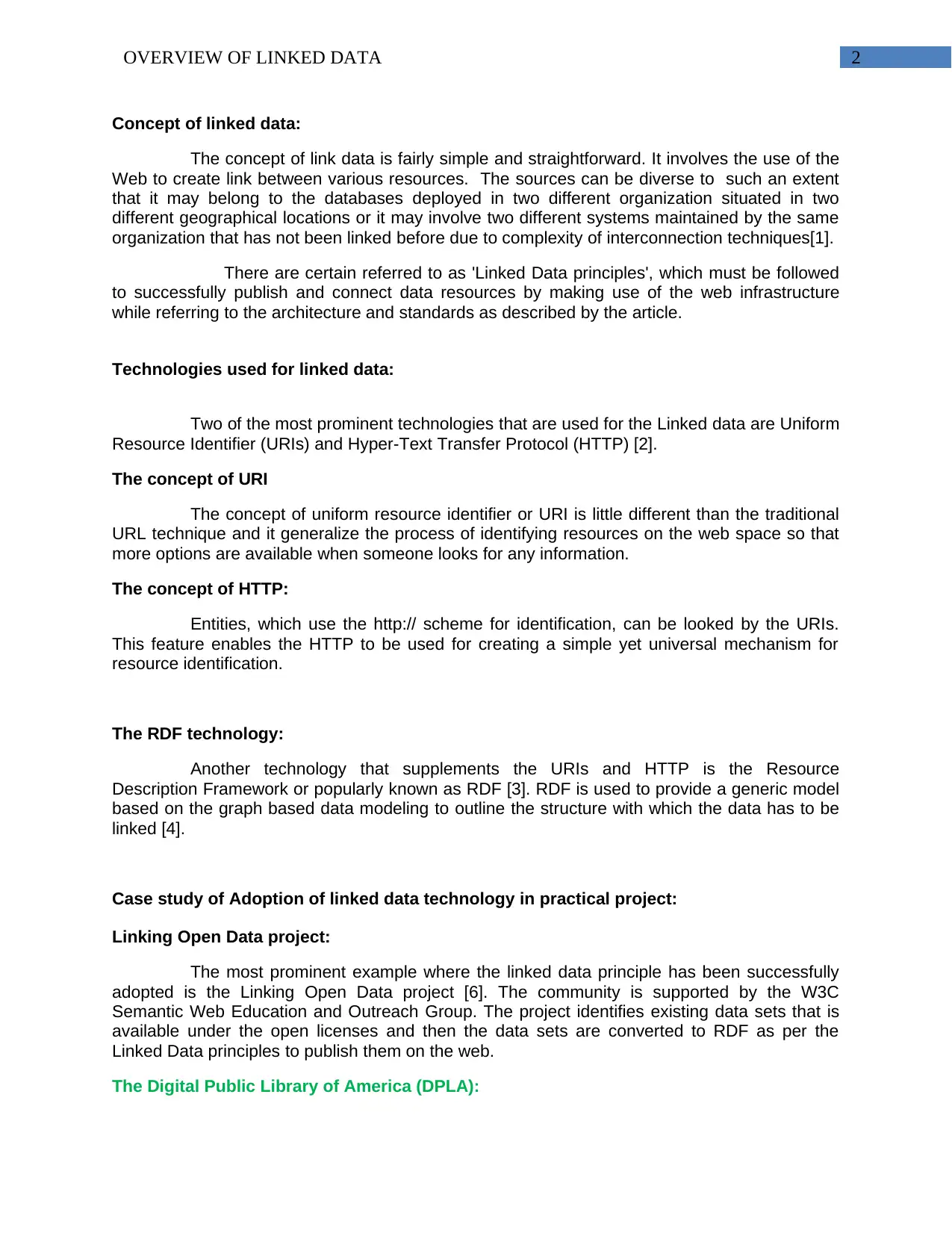
2OVERVIEW OF LINKED DATA
Concept of linked data:
The concept of link data is fairly simple and straightforward. It involves the use of the
Web to create link between various resources. The sources can be diverse to such an extent
that it may belong to the databases deployed in two different organization situated in two
different geographical locations or it may involve two different systems maintained by the same
organization that has not been linked before due to complexity of interconnection techniques[1].
There are certain referred to as 'Linked Data principles', which must be followed
to successfully publish and connect data resources by making use of the web infrastructure
while referring to the architecture and standards as described by the article.
Technologies used for linked data:
Two of the most prominent technologies that are used for the Linked data are Uniform
Resource Identifier (URIs) and Hyper-Text Transfer Protocol (HTTP) [2].
The concept of URI
The concept of uniform resource identifier or URI is little different than the traditional
URL technique and it generalize the process of identifying resources on the web space so that
more options are available when someone looks for any information.
The concept of HTTP:
Entities, which use the http:// scheme for identification, can be looked by the URIs.
This feature enables the HTTP to be used for creating a simple yet universal mechanism for
resource identification.
The RDF technology:
Another technology that supplements the URIs and HTTP is the Resource
Description Framework or popularly known as RDF [3]. RDF is used to provide a generic model
based on the graph based data modeling to outline the structure with which the data has to be
linked [4].
Case study of Adoption of linked data technology in practical project:
Linking Open Data project:
The most prominent example where the linked data principle has been successfully
adopted is the Linking Open Data project [6]. The community is supported by the W3C
Semantic Web Education and Outreach Group. The project identifies existing data sets that is
available under the open licenses and then the data sets are converted to RDF as per the
Linked Data principles to publish them on the web.
The Digital Public Library of America (DPLA):
Concept of linked data:
The concept of link data is fairly simple and straightforward. It involves the use of the
Web to create link between various resources. The sources can be diverse to such an extent
that it may belong to the databases deployed in two different organization situated in two
different geographical locations or it may involve two different systems maintained by the same
organization that has not been linked before due to complexity of interconnection techniques[1].
There are certain referred to as 'Linked Data principles', which must be followed
to successfully publish and connect data resources by making use of the web infrastructure
while referring to the architecture and standards as described by the article.
Technologies used for linked data:
Two of the most prominent technologies that are used for the Linked data are Uniform
Resource Identifier (URIs) and Hyper-Text Transfer Protocol (HTTP) [2].
The concept of URI
The concept of uniform resource identifier or URI is little different than the traditional
URL technique and it generalize the process of identifying resources on the web space so that
more options are available when someone looks for any information.
The concept of HTTP:
Entities, which use the http:// scheme for identification, can be looked by the URIs.
This feature enables the HTTP to be used for creating a simple yet universal mechanism for
resource identification.
The RDF technology:
Another technology that supplements the URIs and HTTP is the Resource
Description Framework or popularly known as RDF [3]. RDF is used to provide a generic model
based on the graph based data modeling to outline the structure with which the data has to be
linked [4].
Case study of Adoption of linked data technology in practical project:
Linking Open Data project:
The most prominent example where the linked data principle has been successfully
adopted is the Linking Open Data project [6]. The community is supported by the W3C
Semantic Web Education and Outreach Group. The project identifies existing data sets that is
available under the open licenses and then the data sets are converted to RDF as per the
Linked Data principles to publish them on the web.
The Digital Public Library of America (DPLA):
You're viewing a preview
Unlock full access by subscribing today!
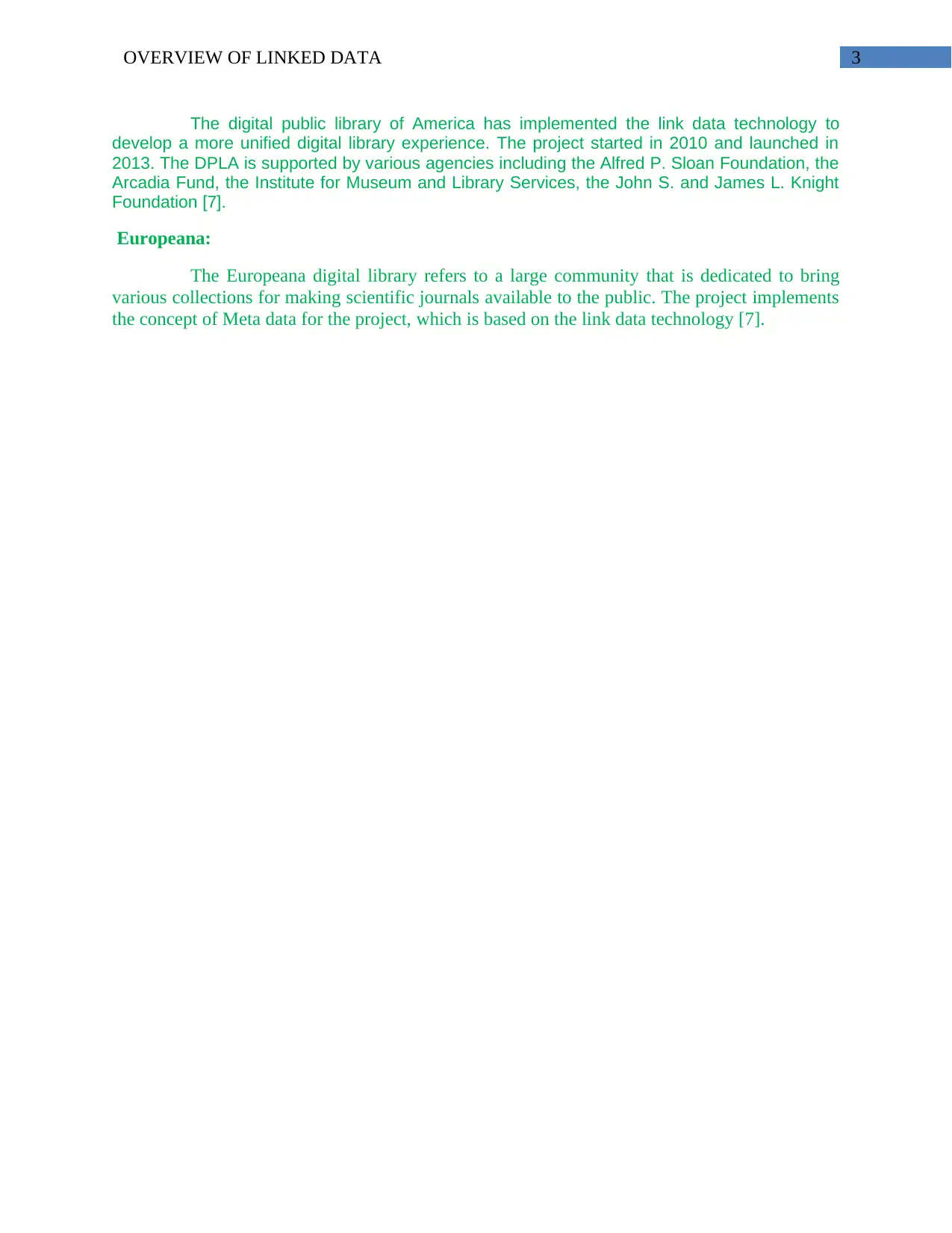
3OVERVIEW OF LINKED DATA
The digital public library of America has implemented the link data technology to
develop a more unified digital library experience. The project started in 2010 and launched in
2013. The DPLA is supported by various agencies including the Alfred P. Sloan Foundation, the
Arcadia Fund, the Institute for Museum and Library Services, the John S. and James L. Knight
Foundation [7].
Europeana:
The Europeana digital library refers to a large community that is dedicated to bring
various collections for making scientific journals available to the public. The project implements
the concept of Meta data for the project, which is based on the link data technology [7].
The digital public library of America has implemented the link data technology to
develop a more unified digital library experience. The project started in 2010 and launched in
2013. The DPLA is supported by various agencies including the Alfred P. Sloan Foundation, the
Arcadia Fund, the Institute for Museum and Library Services, the John S. and James L. Knight
Foundation [7].
Europeana:
The Europeana digital library refers to a large community that is dedicated to bring
various collections for making scientific journals available to the public. The project implements
the concept of Meta data for the project, which is based on the link data technology [7].
Paraphrase This Document
Need a fresh take? Get an instant paraphrase of this document with our AI Paraphraser

4OVERVIEW OF LINKED DATA
Summary to compare Linked Data and NOSQL:
In the overview of NOSQL database technology, the concepts of NOSQL and various
associated technology of NOSQL database has been described in details. It approaches to
analyze the database in a different way from the traditional relational database management
system or commonly known as RDBMS. In the RDBMS, for organizing and retrieving data ,
tables, columns, rows, or schemas is used. However ,NOSQL modifies the techniques by
applying more flexible and dynamic approaches in data modeling. The major problem that
makes the traditional RDBMS technology an inefficient choice for database design is the
inability to make the data base scalable and flexible. However , in the NOSQL database design
the drawbacks of the RDBMS technology is modified allowing it to support more flexible and
scalable database which is an important feature for modern database.
It also highlights the improvement of NOSQL over the standard relational database
system, commonly referred to as SQL database system. Some case studies have been
provided to demonstrate the adaption of NOSQL.
In the overview of Linked data technology, the concept of linked data and various
features of linked data have been described. Link data represent data on the web space in such
an intelligent way that the information is not only meant to be acknowledged by the human, but
rather enabling machines to understand it as well so that meaningful information can be
extracted from the machine in more organized and intelligent way.
The link data is generic in nature and it is capable of containing any kind of data.
Data is free to publish and anyone can do it
The choice of vocabularies to publish the data is completely depends on the publishers
and there is no constrains in that.
The RDF links are provided to connect the entities in order to create a global data map
that expands data resources and helps in the discovery of new data resources.
Link data can be used to either make connection between external data sets or use
those connections to create external data sets itself. It also analyzes the potential and
applications of linked data in the field of web service and development. Additionally, a case
study has been described to demonstrate the adaption. The linked data technology is redefining
the meaning of internet and making the web an global information system in true sense. It can
be concluded that the link data technology will revolutionize the web technology by making it
more smart and advanced.
However, The procedure to make connection between data sets is a challenging task
as it involves data that are huge in volume, frequency and variety, commonly referred to as Big
data. The project considers the cloud architecture in this context. However, it is difficult to
calculate the size of the linked data in exact terms due to high amount of variation in the data
sets that is generated by the wrappers around the relational databases already existing in
practice. Therefore, it is necessary to make the crawling before the data analytics can count and
analyze the data. Although the concept and the benefits that the modern web technology
promises to bring with the link data technology, but the task is challenging and require lot of
effort in terms of design and implementation.
The modern database has evolved in the recent era. The amount of data that is being
generated each and every day is not only enormous, but also comes with variety. In order to
store and deal with the data, the data base has to be compatible with that and due to this the
Summary to compare Linked Data and NOSQL:
In the overview of NOSQL database technology, the concepts of NOSQL and various
associated technology of NOSQL database has been described in details. It approaches to
analyze the database in a different way from the traditional relational database management
system or commonly known as RDBMS. In the RDBMS, for organizing and retrieving data ,
tables, columns, rows, or schemas is used. However ,NOSQL modifies the techniques by
applying more flexible and dynamic approaches in data modeling. The major problem that
makes the traditional RDBMS technology an inefficient choice for database design is the
inability to make the data base scalable and flexible. However , in the NOSQL database design
the drawbacks of the RDBMS technology is modified allowing it to support more flexible and
scalable database which is an important feature for modern database.
It also highlights the improvement of NOSQL over the standard relational database
system, commonly referred to as SQL database system. Some case studies have been
provided to demonstrate the adaption of NOSQL.
In the overview of Linked data technology, the concept of linked data and various
features of linked data have been described. Link data represent data on the web space in such
an intelligent way that the information is not only meant to be acknowledged by the human, but
rather enabling machines to understand it as well so that meaningful information can be
extracted from the machine in more organized and intelligent way.
The link data is generic in nature and it is capable of containing any kind of data.
Data is free to publish and anyone can do it
The choice of vocabularies to publish the data is completely depends on the publishers
and there is no constrains in that.
The RDF links are provided to connect the entities in order to create a global data map
that expands data resources and helps in the discovery of new data resources.
Link data can be used to either make connection between external data sets or use
those connections to create external data sets itself. It also analyzes the potential and
applications of linked data in the field of web service and development. Additionally, a case
study has been described to demonstrate the adaption. The linked data technology is redefining
the meaning of internet and making the web an global information system in true sense. It can
be concluded that the link data technology will revolutionize the web technology by making it
more smart and advanced.
However, The procedure to make connection between data sets is a challenging task
as it involves data that are huge in volume, frequency and variety, commonly referred to as Big
data. The project considers the cloud architecture in this context. However, it is difficult to
calculate the size of the linked data in exact terms due to high amount of variation in the data
sets that is generated by the wrappers around the relational databases already existing in
practice. Therefore, it is necessary to make the crawling before the data analytics can count and
analyze the data. Although the concept and the benefits that the modern web technology
promises to bring with the link data technology, but the task is challenging and require lot of
effort in terms of design and implementation.
The modern database has evolved in the recent era. The amount of data that is being
generated each and every day is not only enormous, but also comes with variety. In order to
store and deal with the data, the data base has to be compatible with that and due to this the
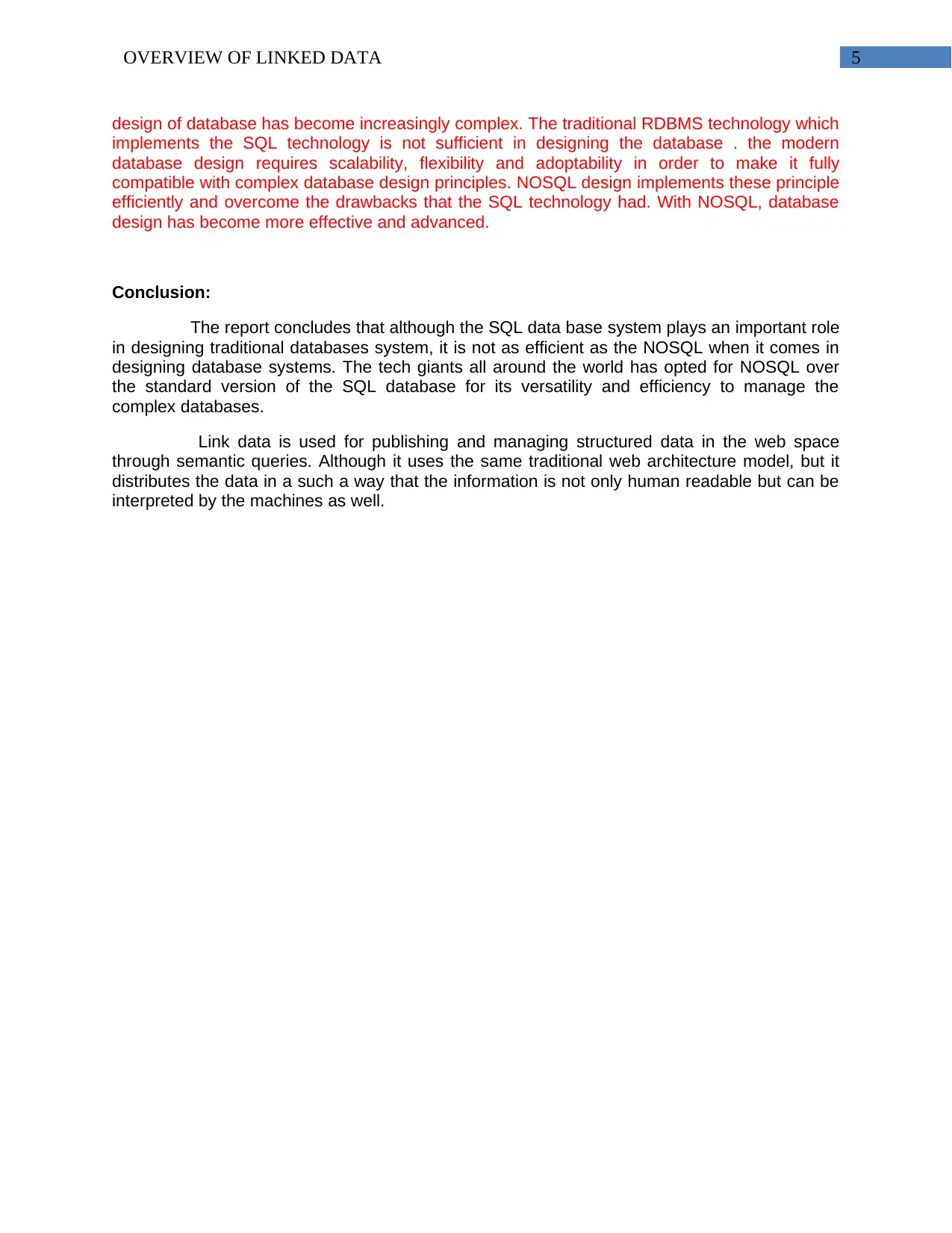
5OVERVIEW OF LINKED DATA
design of database has become increasingly complex. The traditional RDBMS technology which
implements the SQL technology is not sufficient in designing the database . the modern
database design requires scalability, flexibility and adoptability in order to make it fully
compatible with complex database design principles. NOSQL design implements these principle
efficiently and overcome the drawbacks that the SQL technology had. With NOSQL, database
design has become more effective and advanced.
Conclusion:
The report concludes that although the SQL data base system plays an important role
in designing traditional databases system, it is not as efficient as the NOSQL when it comes in
designing database systems. The tech giants all around the world has opted for NOSQL over
the standard version of the SQL database for its versatility and efficiency to manage the
complex databases.
Link data is used for publishing and managing structured data in the web space
through semantic queries. Although it uses the same traditional web architecture model, but it
distributes the data in a such a way that the information is not only human readable but can be
interpreted by the machines as well.
design of database has become increasingly complex. The traditional RDBMS technology which
implements the SQL technology is not sufficient in designing the database . the modern
database design requires scalability, flexibility and adoptability in order to make it fully
compatible with complex database design principles. NOSQL design implements these principle
efficiently and overcome the drawbacks that the SQL technology had. With NOSQL, database
design has become more effective and advanced.
Conclusion:
The report concludes that although the SQL data base system plays an important role
in designing traditional databases system, it is not as efficient as the NOSQL when it comes in
designing database systems. The tech giants all around the world has opted for NOSQL over
the standard version of the SQL database for its versatility and efficiency to manage the
complex databases.
Link data is used for publishing and managing structured data in the web space
through semantic queries. Although it uses the same traditional web architecture model, but it
distributes the data in a such a way that the information is not only human readable but can be
interpreted by the machines as well.
You're viewing a preview
Unlock full access by subscribing today!
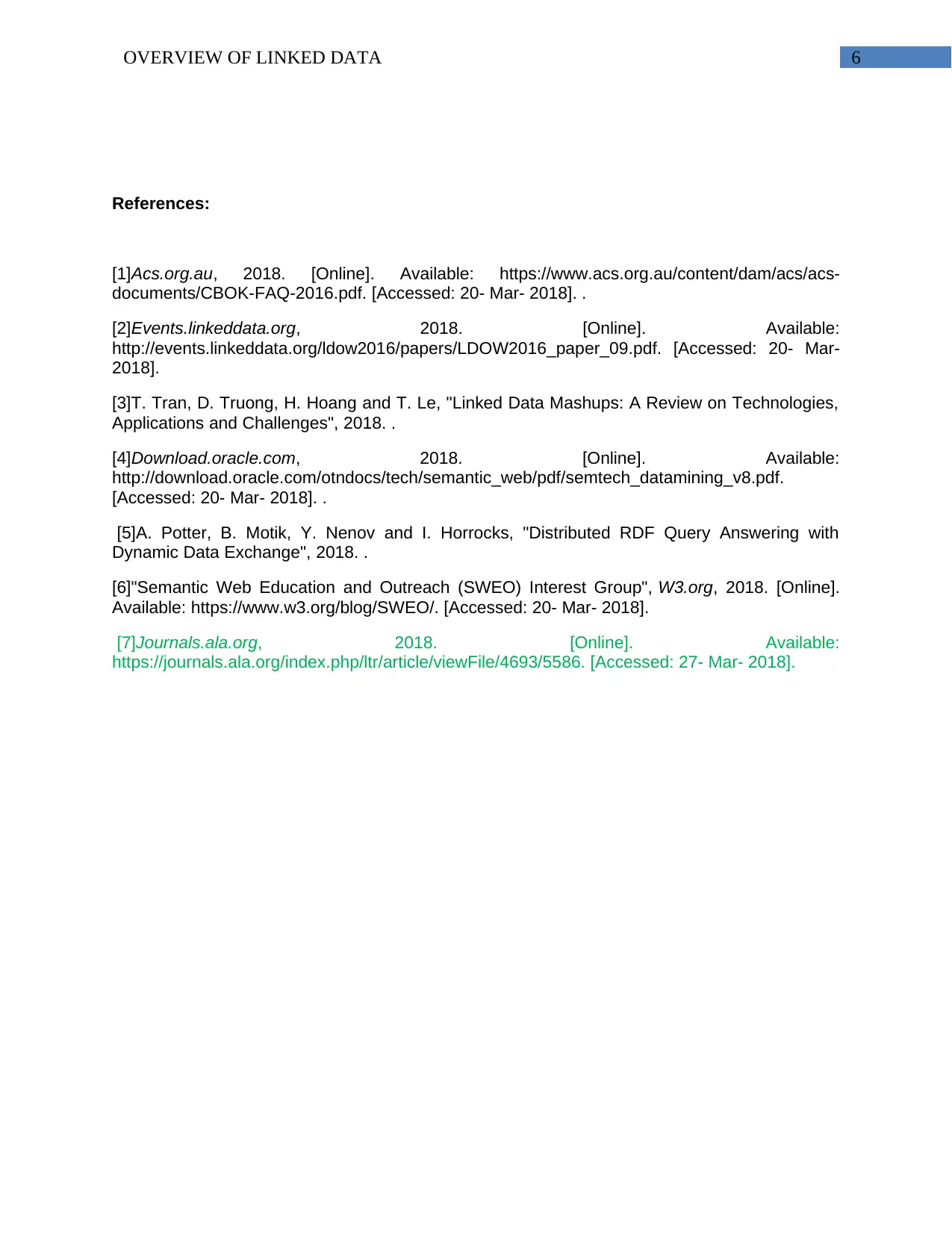
6OVERVIEW OF LINKED DATA
References:
[1]Acs.org.au, 2018. [Online]. Available: https://www.acs.org.au/content/dam/acs/acs-
documents/CBOK-FAQ-2016.pdf. [Accessed: 20- Mar- 2018]. .
[2]Events.linkeddata.org, 2018. [Online]. Available:
http://events.linkeddata.org/ldow2016/papers/LDOW2016_paper_09.pdf. [Accessed: 20- Mar-
2018].
[3]T. Tran, D. Truong, H. Hoang and T. Le, "Linked Data Mashups: A Review on Technologies,
Applications and Challenges", 2018. .
[4]Download.oracle.com, 2018. [Online]. Available:
http://download.oracle.com/otndocs/tech/semantic_web/pdf/semtech_datamining_v8.pdf.
[Accessed: 20- Mar- 2018]. .
[5]A. Potter, B. Motik, Y. Nenov and I. Horrocks, "Distributed RDF Query Answering with
Dynamic Data Exchange", 2018. .
[6]"Semantic Web Education and Outreach (SWEO) Interest Group", W3.org, 2018. [Online].
Available: https://www.w3.org/blog/SWEO/. [Accessed: 20- Mar- 2018].
[7]Journals.ala.org, 2018. [Online]. Available:
https://journals.ala.org/index.php/ltr/article/viewFile/4693/5586. [Accessed: 27- Mar- 2018].
References:
[1]Acs.org.au, 2018. [Online]. Available: https://www.acs.org.au/content/dam/acs/acs-
documents/CBOK-FAQ-2016.pdf. [Accessed: 20- Mar- 2018]. .
[2]Events.linkeddata.org, 2018. [Online]. Available:
http://events.linkeddata.org/ldow2016/papers/LDOW2016_paper_09.pdf. [Accessed: 20- Mar-
2018].
[3]T. Tran, D. Truong, H. Hoang and T. Le, "Linked Data Mashups: A Review on Technologies,
Applications and Challenges", 2018. .
[4]Download.oracle.com, 2018. [Online]. Available:
http://download.oracle.com/otndocs/tech/semantic_web/pdf/semtech_datamining_v8.pdf.
[Accessed: 20- Mar- 2018]. .
[5]A. Potter, B. Motik, Y. Nenov and I. Horrocks, "Distributed RDF Query Answering with
Dynamic Data Exchange", 2018. .
[6]"Semantic Web Education and Outreach (SWEO) Interest Group", W3.org, 2018. [Online].
Available: https://www.w3.org/blog/SWEO/. [Accessed: 20- Mar- 2018].
[7]Journals.ala.org, 2018. [Online]. Available:
https://journals.ala.org/index.php/ltr/article/viewFile/4693/5586. [Accessed: 27- Mar- 2018].
1 out of 7
Related Documents
Your All-in-One AI-Powered Toolkit for Academic Success.
+13062052269
info@desklib.com
Available 24*7 on WhatsApp / Email
![[object Object]](/_next/static/media/star-bottom.7253800d.svg)
Unlock your academic potential
© 2024 | Zucol Services PVT LTD | All rights reserved.





